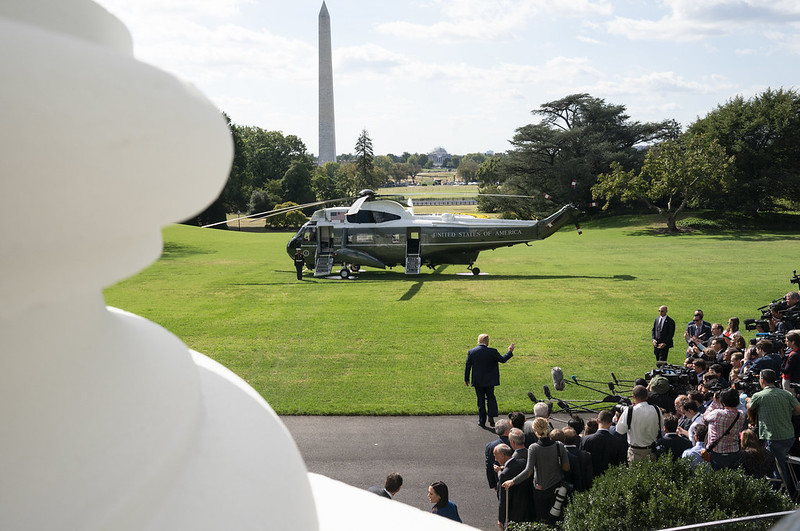President Trump Bars Uninsured Immigrants From the U.S.
On Oct. 4, President Trump issued a proclamation that bars otherwise qualified visa applicants from entry into the United States unless they are likely to obtain “approved health insurance” within 30 days of entry.

Published by The Lawfare Institute
in Cooperation With

On Oct. 4, President Trump issued a proclamation that bars otherwise qualified visa applicants from entry into the United States unless they are likely to obtain “approved health insurance” within 30 days of entry. The insurance test relies on 8 U.S.C. § 1182(f), authorizing the president to bar entry of foreign nationals “detrimental to the interests of the United States”—the same provision that Trump used for his travel ban, which the Supreme Court upheld in Trump v. Hawaii.
But while the Supreme Court in Hawaii relied on the national security and foreign affairs rationale for the travel ban, the insurance test targets the very different issue of immigrants’ financial resources. The Immigration and Nationality Act (INA) specifically addresses this issue in 8 U.S.C. § 1182(a)(4) by barring the admission of a foreign national who is “likely … to become a public charge.” If a challenge to the insurance test ensues and the case reaches the Supreme Court, the outcome will show whether the court believes § 1182(f) is a wide-ranging grant of power to the president to shape all immigration law to his liking, or a more cabined grant focusing on national security and foreign affairs.
Under the new insurance test, which will take effect on Nov. 3, “approved” plans include employer health insurance plans but cannot include a government subsidy—meaning that Obamacare recipients would be unable to sponsor otherwise qualifying relatives. The insurance test bars the entry of spouses, adult children, parents and siblings of U.S. citizens who would otherwise be eligible for visas, as well as the spouses of lawful permanent residents (LPRs). It does not bar the admission of refugees or the minor children of U.S. citizens and LPRs. However, the exemption of minor children highlights hardships created by the test. For example, a U.S. citizen or LPR without approved health insurance would be able to obtain a visa for his foreign national minor children but would not be able to obtain a visa for his wife, even though she is the mother of those children. The full impact of the insurance test will fall on families in which the primary breadwinner works for a salary at or just above the minimum wage: People in this group often lack employer health insurance plans.
Because the primary impact of the insurance test is on low-wage workers, it belongs under the same rubric as the final rule on the INA’s public charge provision, a longtime part of the INA that bars admission of persons who are likely to become dependent on government assistance. The Department of Homeland Security just published this rule after nearly a year of mulling over comments from stakeholders solicited under the Administrative Procedure Act (APA). The rule, which is widely expected to be the subject of legal challenges when it becomes effective later in October, departs from established practice by treating the receipt of noncash benefits such as food stamps, public housing or certain health care coverage as negative factors that officials could cite in finding a foreign national to be inadmissible. Yet, the final rule contrasts with the insurance test imposed by the new presidential proclamation in an important respect: The final rule (see p. 41445) treats lack of nonsubsidized insurance or ability to pay for “reasonably foreseeable” medical care as “one factor in the totality of the circumstances,” not as an absolute bar (emphasis added). The insurance requirement, by contrast, imposes such an absolute bar. In other words, the proclamation’s insurance requirement—apparently imposed without any interagency consultation—is more stark and sweeping than the conclusion just reached by Homeland Security after the APA’s extensive notice and comment process.
The disharmony between the proclamation’s insurance test and Homeland Security’s approach to the same issue signals how the proclamation clashes with venerable canons of statutory interpretation. The general/specific canon presumes that specific provisions, such as the INA’s public charge provision, govern more general grants of authority, such as § 1182(f). As Justice Antonin Scalia noted in RadLAX Gateway Hotel, LLC v. Amalgamated Bank, the general/specific canon has particular relevance to specialized areas of law, such as immigration or bankruptcy, where Congress “has enacted a comprehensive scheme and deliberately targeted specific problems with specific solutions.” In that context, Justice Scalia and his co-author, Bryan Garner, explained in their classic text, “Reading Law” (p. 183), “the specific provision comes closer to addressing the very problem” that Congress sought to address.
A visa applicant’s likelihood of becoming a public charge—a person dependent on government assistance—is one such specific issue. Recognizing the importance of that issue, the administration followed the APA in developing the public charge rule, soliciting comments from stakeholders. In keeping with the APA’s deliberative framework, responding to stakeholders’ comments took almost a year. That time for deliberation is a feature of the APA, not a bug. However, the administration did not subject the insurance test to the APA’s notice and comment process. Instead, the president bypassed the APA by issuing a proclamation under § 1182(f), which allows the president to suspend the entry of immigrants “detrimental to the interests of the United States.” In invoking § 1182(f), the president need not follow the APA’s notice and comment process. However, a clash between a president’s action under § 1182(f) and a duly promulgated rule under a more specific statutory provision may show that the president’s action has exceeded power delegated by Congress.
Trump’s resort to § 1182(f) tees up the issue of that provision’s scope. In Trump v. Hawaii, Chief Justice John Roberts, writing for the court, cited the relationship of both the travel ban and earlier uses of § 1182(f) with U.S. national security and foreign affairs. According to the Supreme Court, the travel ban flowed from an interagency process that recommended the ban as a response to difficulties in vetting of immigrants from certain countries, including countries that were state sponsors of terrorism. Chief Justice Roberts cited the travel ban’s putative goals: to “protect national security and public safety, and induce improvement” in vetting by affected foreign nationals’ home countries. Prior uses of § 1182(f) discussed by the chief justice, such as President Carter’s restrictions on Iranian nationals in the United States during the Iranian hostage crisis or President Reagan’s measures to restrict Cuban immigration to induce changes in the Castro regime’s policies, had a similar national security/foreign affairs signature, enabling the United States to “retaliate for conduct by … [foreign] governments that conflicted with U.S. foreign policy interests.”
In contrast, the new insurance test does not even assert a national security or foreign policy rationale. Instead, it rests entirely on a concern for minimizing health care costs. That concern is legitimate as a policy matter, but the administration should have addressed it as Homeland Security did in dealing with the INA’s public charge provision. While an interagency process led to the administration’s new public charge rule, the insurance test did not emerge from that interagency process and indeed would short-circuit many of the new public charge rule’s criteria. In effect, the insurance test reduces those elaborate criteria to a single question: Does the immigrant have health insurance?
Allowing the administration to issue a proclamation to undermine its own final rule would make a mockery of both the APA and Congress’s carefully constructed immigration framework. Upholding the insurance test would set the stage for unbridled executive efforts to overhaul the INA’s framework in areas far removed from national security and foreign relations. Under the general/specific canon, courts should reject the inference that Congress intended a general provision like § 1182(f) to decimate more specific statutory measures.
As Justice Scalia’s opinion in RadLAX suggests, the Supreme Court’s usual approach to statutory interpretation would invalidate the insurance test. But one can read Hawaii as heralding a greater ambit of deference under § 1182(f). If a challenge to the insurance test reaches the Supreme Court, the outcome will say a great deal about how the usual canons interact with executive power over immigration outside the national security and foreign affairs domain.





